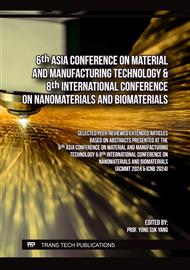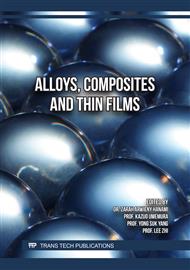p.49
p.57
p.71
p.83
p.91
p.99
p.105
p.111
p.127
The Influence of Friction Stir Welding Parameters on Axial Force and Mechanical Properties of AA6061-T6 Using Taguchi Method
Abstract:
This research investigates the influence of friction stir welding (FSW) parameters on the axial force and mechanical properties, specifically: ultimate tensile strength and Vickers hardness, of AA6061-T6 aluminium alloy using Taguchi experimental design. The study explores various combinations of four factors: rotation speed, welding speed, dwell time, and preheat temperature, each factor with three levels and two replicated, resulting in 18 experiments. The FSW experiments conducted using a CNC machine with parameters derived from the Taguchi experimental design yielded a maximum ultimate tensile strength of 295.66 MPa and a peak Vickers hardness of 81.32 HV. Dynamometer measurements indicated that an average axial force of approximately 2 kN during the welding process produced the most favorable ultimate tensile strength results. Moreover, an analysis of the factors using the Taguchi experimental method, focusing on the signal-to-noise ratio, indicated that to achieve the highest response values, the levels of the factors should be adjusted as follows: a rotation speed of 1250 rpm, a welding speed of 900 mm/min, a dwell time of 20 seconds, and a preheat temperature of 200°C.
Info:
Periodical:
Pages:
105-110
Citation:
Online since:
March 2025
Authors:
Price:
Сopyright:
© 2025 Trans Tech Publications Ltd. All Rights Reserved
Share:
Citation:



